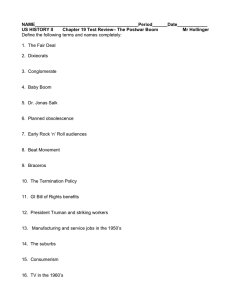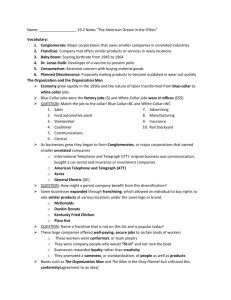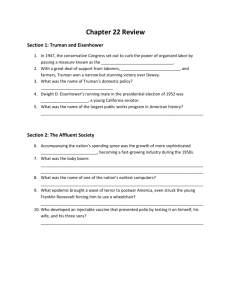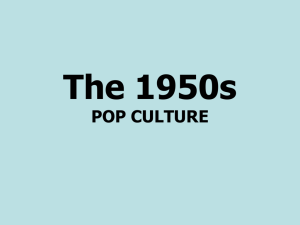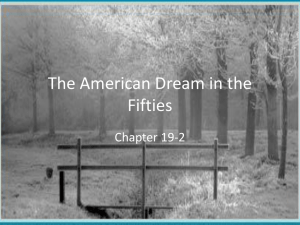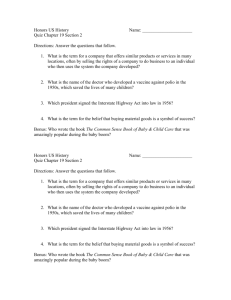1950s Culture
advertisement
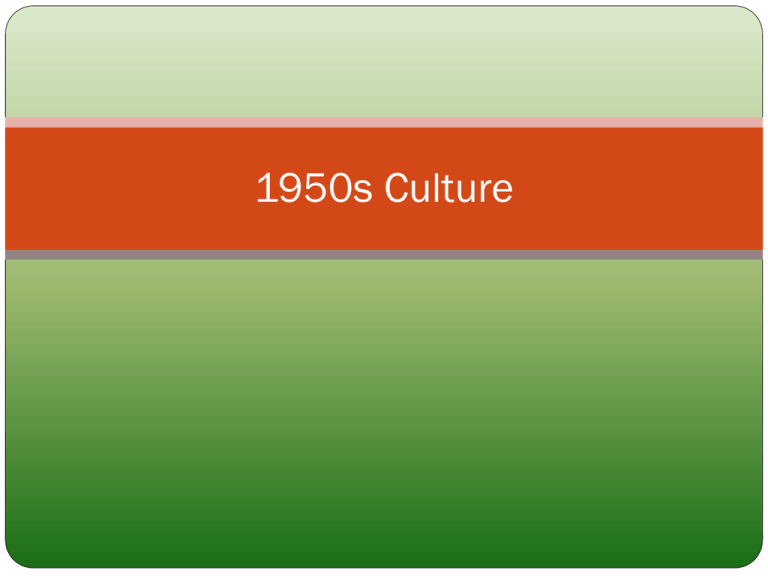
1950s Culture Baby Boom Baby Boom Objectives Terms What caused the Baby GI Bill Boom? Baby Boom GI Bill. Created June 24, 1944 GI BILL Created to help ease soldier back into every day life. Details of Bill Gave job priority to veterans 52 weeks of unemployment monthly allowance low interest loans. Effect Four million veterans bought homes with low interest government loans. A lot of veterans went to college with the money Baby Boom “It seems to me that every other young housewife I see is pregnant.” Baby Boom- Largest Generation in the US History 1957 1 baby born every 7 seconds Baby BOOM! Why? More men in society due to end of WWII. Married at a younger age then their parents ( 1 in 3 women married by age 19) 2. GI bill Helped men to start a family. 1. Medical science improved increasing the survival rate of babies. 2. High flying economy encouraged parents to have babies sooner. 1. Baby Boom Objectives Terms What caused the Baby GI Bill Boom? Men coming home from WWII Increase in Marriages GI Bill Medical Advancements Strong Economy Bill that gave WWII veterans financial assistance after the war. Baby Boom Largest generation in US History Suburbia Suburbia Objectives Terms What major population Levittown trends took place in regards to Suburban and Rural living? What is the make up of a typical House? Suburban Living Levittown “The American Dream” 1949 William Levitt produced 150 houses per week. 1 story high 12’x19’ living room 2 bedrooms tiled bathroom garage small backyard $7,990 or $60/month with no down payment. front lawn Suburb Living Suburbia Clip - Movement to Suburbs SHIFTS IN POPULATION - Movement DISTRIBUTION, Away from 1940-1970 Rural Areas Suburbs Rural Areas/Small Towns 1940 19.5% 48.9% 1950 23.8% 43.9% 1960 30.7% 36.7% U. S. Bureau of the Census. By 1960 1/3 of the U. S. population in the suburbs. Suburbia Objectives Terms What major population Levittown trends to place in regards to Suburban and Rural living? Americans moved away from rural areas and into suburban areas. Name given for standard suburban housing built in the 1950s Television Culture and Consumerism Consumerism Objectives Terms What trends took place in the television industry during the 1950s? What lead to the increase in consumerism during the 1950s? What were the tobacco usage trends of the 1950s? What were the trends regarding car usage in the 1950s? Interstate Highway Act The Television Revolution 1946 7,000 TV sets in the U. S. 1950 50,000,000 TV sets in the U. S. Black and White Television – The Western Davy Crockett King of the Wild Frontier Sheriff Matt Dillon, Gunsmoke The Lone Ranger (and his faithful sidekick, Tonto): Who is that masked man?? Lone Ranger The Television Family Shows like Leave it to Beaver, and I love Lucy portrayed a perfect family life and not the reality of everyday homes. Moms were always pretty and doing domestic things Children were adventurous but obedient Dads never worked late, never lost their temper and knew all the right answers. The Typical TV Suburban Families Leave It to Beaver The Donna Reed Show 1958-1966 I Love Lucy Father Knows Best 1954-1958 Leave It to Beaver 1957-1963 The Honeymooners Consumerism Good Economy + Advertising TV RADIO MAGAZINES NEWSPAPERS = Lots of Spending Advertising continued… 1950s was the Golden Age for smoking You could smoke Anywhere Anytime Cheap Age of the Cigarette Doctors Smoke The Culture of the Car Car registrations: 1945 25,000,000 1960 60,000,000 2-family cars doubles Interstate Highway from 1951-1958 Act Largest public works project in American history! Cost $32 billion. 41,000 miles of First McDonald’s (1955) Drive-In Movies new highways built. Consumerism Objectives What trends took place in the television industry during the 1950s TV sets increased dramatically What lead to the increase in consumerism during the 1950s? Strong Economy Advertising What were the tobacco usage trends of the 1950s? Tobacco usage very common All ages, all genders What were the trends regarding car usage in the 1950s? 2 car families and car registration doubled Terms Interstate Highway Act Largest public works project in American history! Gender Roles Gender Roles Objectives What were the ideal Gender Roles of the Males in the 1950s? What were the ideal Gender Roles of the Females in the 1950s? Terms Duck and Cover Society Well-Defined Gender Roles Gender Roles as of Life magazine, 1955 Ideal Woman Married Young Cooked and cared for her family Kept herself busy by joining local clubs Entertained guests Ideal Man Provider for family Protector of family Boss of the house Took care of outside work Role of middle class women. Women were told to be “helpmates” to their husband’s and full time mothers to their children “A woman isn’t a woman until she is married and had children.” Working women were called “a menace” The ideal wife was married at 16, raised 4 children, cooked and sewed, headed the PTA and exercised to keep her size 12 figure 1950s Home Ed Book 1950s Video Duck and Cover Society Cold War had and effect on People “Duck and Cover Society” Fear of Nuclear War Bomb shelters Two Different Boys Mr. Tough Guy Mr. Clean Break Rules Obey Authority. Control Your Emotions. Don’t Make Waves Fit in Show anger Loner Don’t bring home to visit mother with the Group. Don’t Even Think About Sex!!! Gender Roles Objectives What were the ideal Gender Roles of the Males in the 1950s? Provider for family Protector of family Boss of the house Took care of outside work What were the ideal Gender Roles of the Females in the 1950s? Married Young Cooked and cared for her family Joined local clubs Entertained guests Terms Duck and Cover Society Fear of Nuclear War Creation of bomb shelters Music and Fashion Gender Roles Objectives What were the major fashion trends for women in the 1950s? What were the major fashion trends for men in the 1950s? Terms Bubble Gum Music Rock N Roll Music Movies 1950s Movies Science Fictions 3-D Movies 1950s Music Bubble Gum Sweet sound and nice lyrics Light Melodies Innocent Lyrics Wholesome Singers Music reflected the Post W.W.II good feelings Rock n Roll Very new sound Exciting and racy melodies/lyrics Sex Symbols Music represented new age of kid “teenager” 1950s Fashion Women A time to wear Dresses Hourglass look is back Circle Skirt Poodle Skirt- most popular Pencil Skirt Chemise Dress Tube dress with a belt Other Trends Floral Patterns Sleeveless tops Kakis were ok for casual affairs Hair Youth- Long- Pony tails Older you get the shorter it gets or you put it up Teenage Girls Skits and Prom Dresses 1950’s Pants/Outfits 1950s Male Fashion A time to be comfortable but yet formal Suit jackets with stripes became as much in demand as plain colored jackets. Shirts were often short, loose, and with short sleeves. Button up shirts were the norm Plaid and Checkered patterns Leather jackets became a huge rage Formal Hats Most male preferred wearing pants made of Khaki Shirts and Hats 1950’s Hair Gender Roles Objectives What were the major fashion trends for women in the 1950s? Dresses very popular Hourglass look back Causal – Blouse and Kakis Hair Young – Long Old- Pull up or short What were the major fashion trends for men in the 1950s? Work- Suit and Tie Causal- Kakis and button up shirt Hair High and Tight Hats Terms Bubble Gum Music Light Melodies Innocent Lyrics Rock N Roll Music Exciting and racy melodies/lyrics Sex Symbols Telephone Cramming Comes to California in 1959. 22 in America
